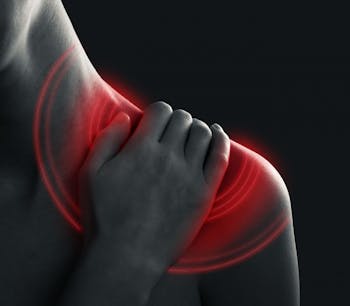-
What is Arthritis?
Arthritis is inflammation of one or more of your joints that causes stiffness, swelling and tenderness. There are more than 100 types of arthritis. So, symptoms can vary widely depending on what type of arthritis you have and how severe it is.
Two of the most common types of arthritis are osteoarthritis (OA) and rheumatoid arthritis (RA). They both involve the breakdown of cartilage, but the cause of the breakdown is different.
- Osteoarthritis is a disease that typically involves age-related wear and tear of the cartilage that slowly progresses over many years before joint damage begins. Although, infection or injury can speed up the natural breakdown of cartilage. An estimated 27 million Americans are affected by OA.
- Rheumatoid arthritis is a disease of the synovium that mistakenly invades and destroys joints in the body, which can eventually cause the destruction of the bone and cartilage inside the joint. Most people with RA start developing joint damage within 2 years. But, some people may start experiencing joint damage as early as 3 months after the onset of RA symptoms. Approximately 1.5 million U.S. adults have RA.
Who Can Develop Arthritis?
Arthritis is a very common condition that affects over 3 million Americans of all ages per year. Even children develop arthritis, including newborns. Genetic markers in your family history can increase your risk of developing arthritis.
Physical Therapy Can Help
Physical therapists (PTs) are experts in the art and science of the evaluation and treatment of human movement dysfunctions. We care for people of all ages and treat a variety of muscle, joint and neurological conditions.
Conditions we have successfully treated:
- Joint Pain
- Osteoarthritis
- Rheumatoid Arthritis
- Knee Arthritis
- Hip Arthritis
- Shoulder Arthritis
- Hand Arthritis
What are my treatment options?
- Drugs
- Epidural Injections
- Surgery
- Physical Therapy*
Advantages of Physical Therapy:
- No side effects.
- Cost-effective.
- Supported by clinical research*.
- Customized to treat the underlying cause.
Your Recovery Process:
- Recovery of Joint Motion
- Recovery of Strength
- Pain Relief
- Improved Function
- Independent Care
Components of Your Care:
- A thorough biomechanical evaluation.
- Extensive patient education.
- A customized treatment plan.
- Effective joint mobilization techniques to decrease joint stiffness.
- Pain-relieving modalities such as ice, heat, ultrasound or electrical stimulation.
- Targeted stretching for tight muscles.
- Progressive strength training.
- Balance and functional re-education.
Everyone is different. You may require one or two visits or an extended care plan over several weeks or months. If you’re ready for relief, and tired of “masking” your pain, treat the cause, not just the symptoms!
* Physical therapy techniques are recommended for arthritis of the knee, hip, shoulder, and hand. Physical Therapy 2005 85: 907-971; Physical Therapy 2004 84: 934-972.
-
Chronic Pain
Pain is the most common reason for seeking medical care. It is also the most common reason why people choose our physical therapy practice for help. If you are considering physical therapy for pain, this information can help.
Acute, Subacute, and Chronic Pain
Acute pain is common with tissue damage that may occur with a ligament sprain, a muscle or tendon strain, inflammation within a joint, or a tear of a muscle, tendon, or meniscus.
Subacute pain is pain that lasts for 3 to 6 months. Subacute pain is common with more complex conditions where there is prolonged healing (joint replacements and the pain associated with the recovery after surgery).
Chronic pain is pain lasting for more than 6 months. While the body’s musculoskeletal tissues may heal from an initial injury or degenerative change, pain may persist for months past the tissue healing process. Nearly 50 million American adults have significant chronic pain or severe pain, according to a new study prepared by the National Institutes of Health’s National Center for Complementary and Integrative Health (NCCIH). (1)
IMPORTANT: within 6 months almost all tissue damage completely heals. It is rare when the body cannot heal itself. Rare cases of diabetes may limit the healing process; however, in almost all cases, tissue healing will occur within 6 months.
What is Pain? Pain is an Output, not an Input.
Pain is the combination of numerous factors that result in a conscious experience that demands your attention.
Below is a list of many of the factors that contribute to your conscious experience of pain.
In other words, pain is NOT damaged tissue that is stimulating pain nerves which send pain signals through pain nerves up to your brain. There’s much more to it.
The good news is that means there are lots of ways to positively impact your pain.
Our specially trained physical therapists can help patients with chronic pain.
Here are some of the factors that contribute to your perception of pain:
- Injury & inflammation - tissue damage itself, stimulates nerves that work through the spinal cord and may be perceived as pain.
- Neurophysiology – the way the nervous system works, the body’s threat sensors, how they interact at your spinal cord, and the pattern of activity (pain neuromatrix), can all impact your perception of pain. Your brain also has an internal medicine cabinet that can release some of the most powerful drugs known to help minimize pain. These are called endorphins & enkephalins.
- Pain Experience – your perception of pain. There is good pain and bad pain. Past experiences with pain matter.
- Fear – some may have no fear of pain when they experience pain, while others may be thinking about the worst possible outcomes because of the pain (catastrophizing).
- Helpful vs. Harmful Words – improper use of diagnoses, terms, diagnostic test results, and communications with patients can be helpful or harmful. For example, a positive MRI for a disc bulge, disc tear, herniation, or arthritis is rarely helpful. Why? Scientists have performed MRIs on hundreds of patients, THAT DON’T HAVE ANY PAIN AT ALL
- Knowledge About Pain – understanding that pain is complex and much more than just damaged muscle, tendon, ligament, or joint tissue can help relieve the pain.
- Avoidance of Movement - pulling back because of pain or fear of pain
- Deconditioning – movements that are normally pain-free or don’t cause fatigue, may stimulate chronic pain. In other words, with fear and avoidance, your body can get out of shape; movements that usually don’t cause pain or fatigue, can cause pain.
- Emotions – when emotions are low, pain is typically less, and when emotions are high, the brain may put out the perception of pain
- Hormones – hormones like adrenalin and cortisol have been shown to impact pain
- Stress – family, financial, and work stress all play a role in the perception of pain.
- Contributing Health Conditions – anxiety & depression both can factor into chronic pain
- Sleep Habits – proper sleep habits can certainly help with the perception of pain. Almost everyone has had a headache when they were tired. The headache doesn’t mean you have cancer, it means you didn’t get enough rest.
- Nutrition – eating the proper foods can positively impact pain
- Hormones – certain hormones can decrease or in some cases increase your perception of pain.
The Principles of Chronic Pain Treatment
New ideas studied by pain scientists suggest that there are four basic components to the successful treatment of pain.
- Pain education – pain neuroscience education (PNE) or therapeutic neuroscience education (TNE) helps patients understand that pain is an output from the brain, it’s complex, and not just in your head.
- Exercise – numerous scientific studies have demonstrated that paced & graded exercise can have an extremely positive impact on pain.
- Sleep Health – addressing sleep issues can also decrease pain
- Goal Setting – it took months, even years for your body and brain to experience the chronic pain. Setting specific, reasonable, and progressive goals are part of a successful chronic pain treatment program.
We’ve Only Scratched the Surface of All the Great Treatments Our Therapists Can Provide!
If you have chronic pain, we encourage you to set up an appointment with one of our physical therapists. We will take a thorough health history, perform a physical exam, create a custom program for you and help put you back on the road to recovery.
Call Us Today
-
Coronavirus Update
COVID-19 and Your Safety
- Our office is open and accepting appointments to provide essential care to patients. Our clinic is in complete compliance with current CDC protocols.
- We are screening all patients for possible exposure to COVID-19.
- Special attention and precautions are given to those over age 65 and those with other conditions that may put them at higher risk.
- Our staff and patients are wearing masks, gloves when appropriate and washing hands frequently.
- Commonly accessed areas are cleaned and sanitized frequently.
- Free phone consultations are available to all patients and those individuals who may call in with questions.
- Request An Appointment
- Pay Your Bill Online
Connellsville
171 W Crawford Avenue
(724) 628-7288
Scottdale
109 Crossroads Road
(724) 887-4181
Uniontown
295 Morgantown St
(724) 550-4315


